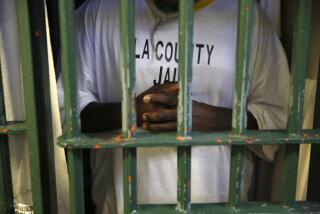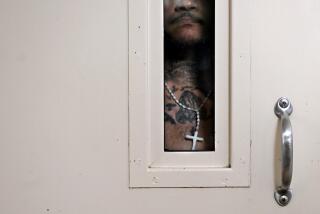Editorial: Coronavirus makes jails and prisons potential death traps. That puts us all in danger

Despite the worldwide consensus on the best measures people can take to protect themselves from the coronavirus, there are more than 2 million people in the United States who cannot practice social distancing, are prohibited from using or even possessing hand sanitizer and who cannot wash their hands without permission.
As inmates in local jails and state and federal prisons, they are virtually defenseless against the virus. In jails especially — where quarters are cramped, inmate turnover is high, and thousands of people are admitted each day — it is only a matter of time before an infected person who does not yet show symptoms enters one of these locked institutions. And once the virus enters such a confined space, it will spread.
Certainly this is a crisis for the inmate population, which is made up largely of people from socially and economically marginalized communities and suffers disproportionately from medical and mental health problems.
And of course it is a crisis for their families, whom they will be rejoining.
But it is a crisis as well for the rest of us for two distinct reasons: First, they are part of our community, and we as a society are responsible for their safety during the period in which we have locked them up with no ability to practice the protective measures that the rest of us do — the distancing, the hand washing.
And second, for those observers who might shrug over the fate of prisoners, it is important to remember that inmates are released every day to rejoin the rest of us.
The average jail stay in Los Angeles County is around 10 days. An infected but symptom-free inmate could easily enter and leave jail, unknowingly spreading the virus to hundreds of others who also will be leaving within a week or two. No jail or prison in the U.S. tests every inmate either coming in or going out for the virus. There simply aren’t enough tests available.
In China, a decline in new infections was quickly (although briefly) reversed because of rapid outbreaks in two prisons. In Italy, an atmosphere of fear and anxiety among prison inmates over the virus, together with an emergency ban on visitors, sparked deadly riots, escapes and a complete breakdown of authority. In Iran, officials saw the urgent need to temporarily defuse similar potential disasters by granting furloughs to tens of thousands of prisoners.
Thankfully, a handful of county officials in the U.S. also see the wisdom of lowering the danger in jails and prisons from the virus by quickly reducing the number of inmates. Here in Los Angeles, Sheriff Alex Villanueva took a number of steps to trim the nation’s largest jail population.
Inmates with 30 days or fewer left on their sentences have been released. The sheriff has asked police departments to limit arrests to only dangerous suspects, thereby decreasing new entries. Defendants awaiting trial who have bail set at $50,000 or less are cited and released.
These are smart and responsible moves to reduce the threat of a coronavirus disaster in jails. But that still leaves more than 16,000 people behind bars. There is so much more that can and should be done in jails, where stays are short, as well as prisons, where they are much longer.
Virtually no defendant should be admitted to jail during this emergency who does not pose a risk to public safety. By definition that includes anyone with bail set, whether they can pay it or not, and anyone subject to jail for a technical parole or probation violation. There are alternatives to incarceration that promote safety and fulfill the public’s need to see justice done; now is the time to employ them.
For those already in jail, Villanueva is right to let out people who would be leaving within a few weeks anyway. But a coalition of elected U.S. district attorneys has argued that anyone with six months or less to run of their sentence, and not just 30 days, should also be let out.
In federal prisons, still filled with inmates from the 1990s war on drugs, the fastest-growing segment is prisoners age 55 and older. State prisons have large numbers of people with complex medical problems. Few at that age pose a risk to society, and most should be granted furloughs or compassionate early release when it is safe to do so.
During this emergency, time is of the essence. Judges and prosecutors should understand the importance of reducing new jail and prison admittances. Sheriffs and wardens should see the wisdom in reducing their inmate populations to only those who need to be there for public safety. If they need statutory authority for releases, lawmakers should act swiftly to grant it.
And then, when the crisis abates and we have caught our collective breath, we can ask ourselves why we lock up so many suspects, defendants and convicts in the first place, and whether they all need to be behind bars for us to be safe.
More to Read
A cure for the common opinion
Get thought-provoking perspectives with our weekly newsletter.
You may occasionally receive promotional content from the Los Angeles Times.










